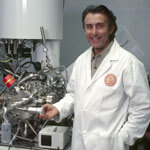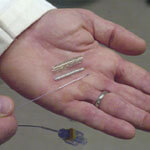
Tinkering in the garage led a young doctor to create a device that would impact the world in more ways than anyone could have imagined. World-renowned inventor and radiologist Julio Palmaz, M.D., the Ashbel Smith Professor at the Health Science Center, was inducted into the National Inventors Hall of Fame during a ceremony May 5-6 in Akron, Ohio. Dr. Palmaz, a native of Argentina, was selected by a national committee for his revolutionary Palmaz® stent, which has been hailed as one of the “10 Patents That Changed the World” (as cited in the August 2002 issue of IP Worldwide magazine).
“This treatment is now commonplace, but it was unknown 25 years ago. Prior to stenting, the main treatment for opening constricted arteries was balloon angioplasty or bypass surgery,” Dr. Palmaz said. “It is an honor that the National Inventor’s Hall of Fame has chosen to include me in this esteemed group of inductees.”

The stent is a tiny wire-mesh, spring-loaded tube threaded through a blood vessel with a balloon catheter (the procedure is called angioplasty). After balloon deflation and removal, the stent remains as a permanent scaffold to keep the vessel open.
Dr. Palmaz gained a U.S. patent on the stent in April 1988. The U.S. Food and Drug Administration approved the stent for use in peripheral vascular arteries in 1990 and for use in coronary arteries in 1994. Stents are now deployed in 2 million patients annually to repair clogged arteries near the heart and elsewhere in the body. The stent has been on display at the Smithsonian Institution’s National Museum of American History in Washington, D.C.
The National Inventors Hall of Fame is the premier not-for-profit organization in America dedicated to recognizing, honoring and encouraging invention and creativity through the administration of its programs. The Hall of Fame honors the men and women responsible for the great technological advances that make human, social, and economic progress possible. For more information, visit the Web site at www.invent.org.

